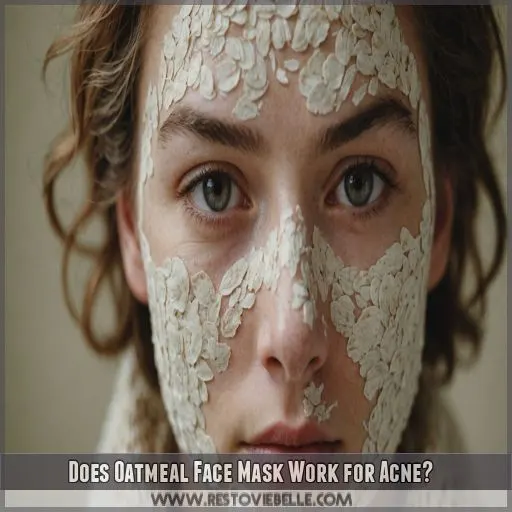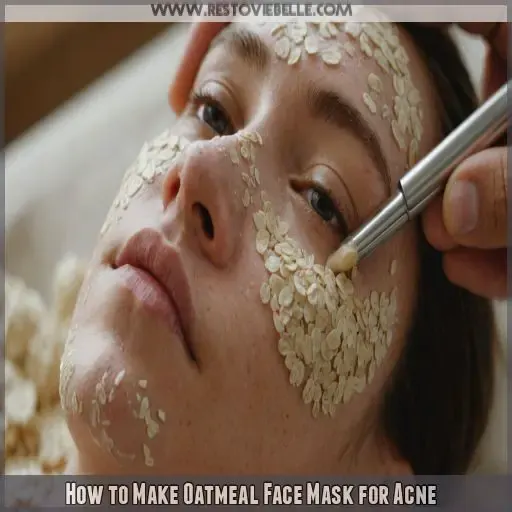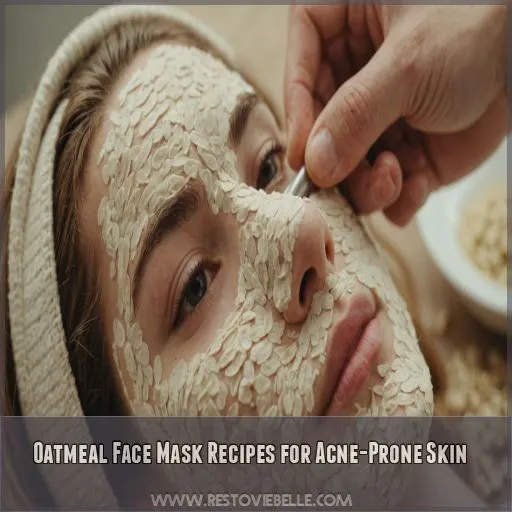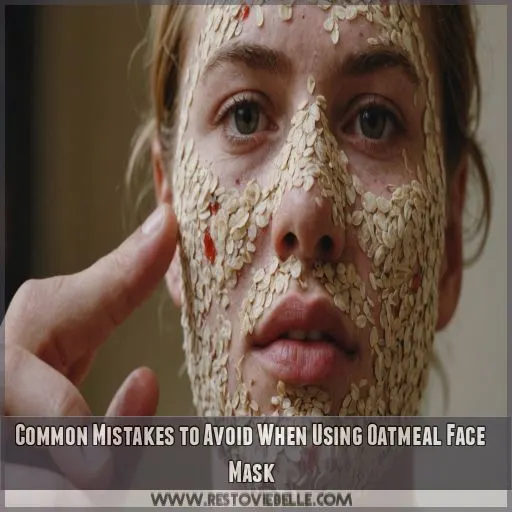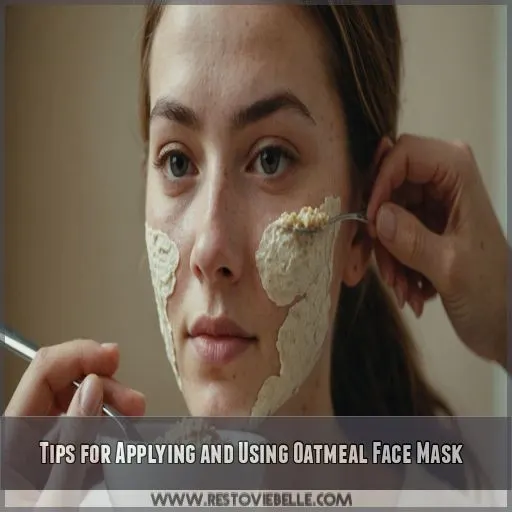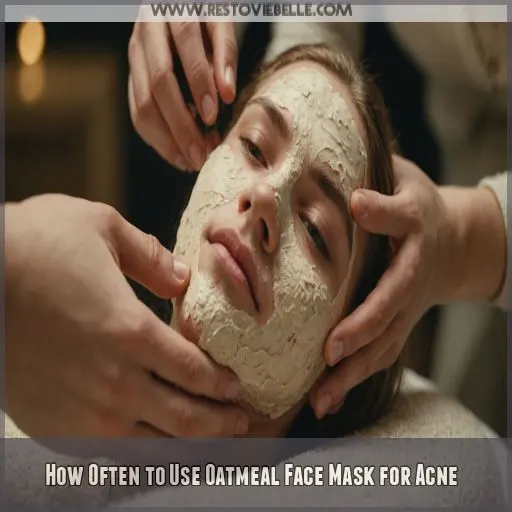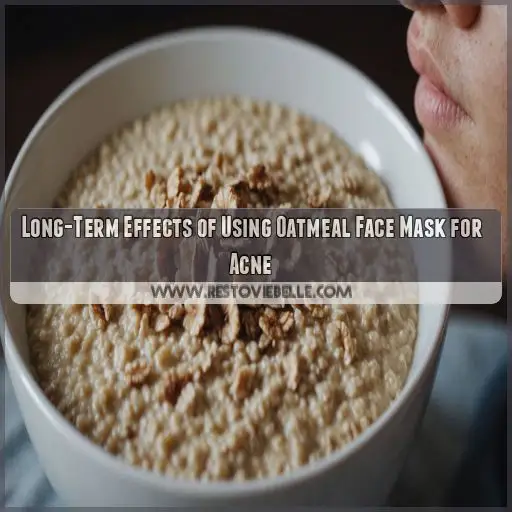This site is supported by our readers. We may earn a commission, at no cost to you, if you purchase through links.
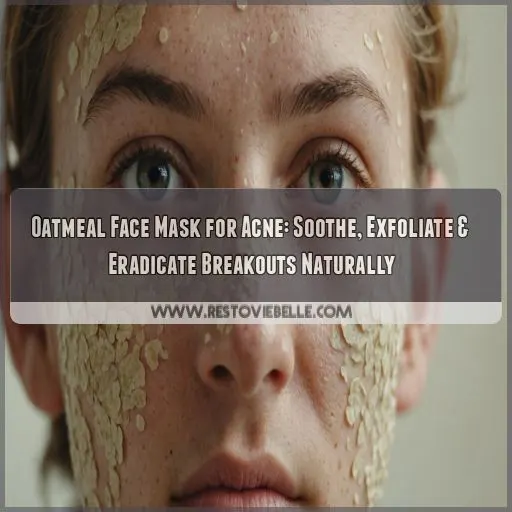
Oatmeal’s anti-inflammatory and antioxidant properties can soothe redness, absorb excess oil, and even help eradicate breakouts.
By using an oatmeal face mask, you’re not just calming your skin, but also gently exfoliating and unclogging pores.
Ready to give it a try?
Mix 2 tablespoons of oatmeal with 1 teaspoon of baking soda and water, apply for 10 minutes, and rinse for a clearer complexion.
Discover how this simple, natural remedy can transform your skin and become your new go-to acne-fighter!
Table Of Contents
- Key Takeaways
- Oatmeal Face Mask Benefits for Acne
- Does Oatmeal Face Mask Work for Acne?
- How to Make Oatmeal Face Mask for Acne
- Oatmeal Face Mask Recipes for Acne-Prone Skin
- Common Mistakes to Avoid When Using Oatmeal Face Mask
- Tips for Applying and Using Oatmeal Face Mask
- Benefits of Combining Oatmeal With Other Natural Ingredients
- How Often to Use Oatmeal Face Mask for Acne
- Long-Term Effects of Using Oatmeal Face Mask for Acne
- Frequently Asked Questions (FAQs)
- Is oatmeal face mask good for acne?
- How do you make oatmeal for acne?
- Does oatmeal and honey work for acne?
- Does oatmeal mask clog pores?
- Can oatmeal face masks be used on sensitive skin types?
- How does oatmeal face mask compare to commercial acne products?
- What are the potential side effects of using oatmeal masks?
- Can oatmeal face masks be used in combination with medication?
- Are there any age restrictions for using oatmeal face masks?
- Conclusion
Key Takeaways
- Oatmeal face masks are like a warm hug for acne-prone skin – they soothe, calm, and gently exfoliate, making them a game-changer for tackling breakouts and achieving a clearer complexion.
- With its anti-inflammatory and antioxidant properties, oatmeal can help reduce redness, absorb excess oil, and even combat acne-causing bacteria, making it a potent natural remedy for acne.
- Combining oatmeal with other natural ingredients like honey, lemon juice, and yogurt can supercharge its benefits, creating a customized mask that addresses specific skin concerns, from dryness to oiliness.
- For maximum benefits, use an oatmeal face mask once a week, adjusting frequency based on your skin type and concerns, and don’t forget to moisturize afterwards to keep your skin hydrated and primed for the mask’s nourishing goodness.
Oatmeal Face Mask Benefits for Acne
If you’re struggling with acne, an oatmeal face mask can be a game-changer. With its anti-inflammatory and antioxidant properties, oatmeal can help soothe and calm your skin, reducing inflammation and unclogging pores to leave you with a clearer, more radiant complexion.
Reduces Inflammation and Soothes Skin
Discover the calming power of oatmeal for acne-prone skin! This natural anti-inflammatory ingredient reduces redness and soothes sensitive skin, making it an ideal addition to your DIY soothing routine. Find relief from acne with an oatmeal calming mask, and say goodbye to irritated skin!
Natural Exfoliant for Blackheads and Whiteheads
Exfoliating with oatmeal is a game-changer for blackheads and whiteheads. Mix colloidal oatmeal with water or add baking soda for a gentle scrub. Unlike harsh sugar scrubs, oatmeal soothes while removing dead skin cells, revealing brighter, healthier-looking skin.
Absorbs Excess Oil and Unclogs Pores
Now that we’ve tackled blackheads and whiteheads, let’s talk about how oatmeal face masks can absorb excess oil and unclog pores. By controlling oil production and deep cleansing, oatmeal helps reduce pore size, making it an excellent natural remedy for oily skin.
Anti-Inflammatory and Antioxidant Properties
You can harness oatmeal’s anti-inflammatory and antioxidant powers to calm acne-prone skin. Rich in saponins, oatmeal helps reduce inflammation and fights free radicals that accelerate skin aging. By incorporating oatmeal into your skincare routine, you’ll be soothing and protecting your skin naturally.
Does Oatmeal Face Mask Work for Acne?
You’re probably wondering if an oatmeal face mask is just another DIY fad or if it can actually help with acne. The good news is that research suggests oatmeal does have anti-inflammatory and antimicrobial properties that can soothe, exfoliate, and even help eradicate breakouts .
Understanding How Oatmeal Fights Acne
Let’s talk about how oatmeal fights acne. If you’re struggling with breakouts, you might be wondering if oatmeal can really help. Here’s the deal: oatmeal has anti-inflammatory properties that can soothe and calm your skin. It’s also packed with saponins, which have antimicrobial powers to combat acne-causing bacteria. Plus, oatmeal can help unclog pores and reduce excess oil. Here are three ways oatmeal takes on acne:
- Fights inflammation: Oatmeal’s anti-inflammatory properties calm and soothe your skin.
- Unclogs pores: Oatmeal helps to clear out dirt and oil, reducing breakouts.
- Zaps bacteria: Saponins in oatmeal kill off acne-causing bacteria, keeping your skin healthy.
Scientific Research and Studies on Oatmeal for Acne
You want to know if oatmeal face masks really work for acne? Let’s look at the science.
Research suggests that oatmeal’s anti-inflammatory and antioxidant properties can help soothe and calm acne-prone skin .
Studies have also shown that oatmeal’s saponins, a type of natural compound, have antimicrobial properties that can help reduce acne-causing bacteria .
While more research is needed, the existing evidence is promising. So, go ahead and give oatmeal a try – your skin might just thank you! (Source)
How to Make Oatmeal Face Mask for Acne
Making an oatmeal face mask for acne is a breeze, and you can whip one up with just a few simple ingredients you likely have on hand (Source). To get started, you’ll need some oatmeal, water, and optional add-ins like honey or lemon juice to boost the mask’s acne-fighting power (Source).
Simple Recipe With Oatmeal and Water
You’re just two ingredients away from a soothing oatmeal face mask. Mix 3 tablespoons of ground oats with 1 tablespoon of warm water to create a smooth paste. Adjust the consistency as needed, and you’re ready for application.
Adding Honey for Antibacterial Properties
When making an oatmeal face mask for acne, consider adding honey for its antibacterial properties. Research shows that honey can help combat acne-causing bacteria, reducing breakouts and promoting clearer skin. Mix 1 tablespoon of honey with 2 tablespoons of oatmeal for a soothing and effective mask.
Incorporating Lemon Juice for Astringent Benefits
When incorporating lemon juice into your oatmeal face mask, be careful – it can be harsh on sensitive skin. Start with a small amount (about 1-2 teaspoons) and adjust to taste. Lemon juice helps balance skin tone, reduce oily skin, and minimize pore size.
Using Colloidal Oatmeal for Enhanced Benefits
Now that you’ve added lemon juice, let’s take it up a notch with colloidal oatmeal. This finely ground oat powder is a powerhouse for acne-prone skin, enhancing skin barrier function, moisture retention, and anti-inflammatory effects – making it a fantastic addition to your DIY recipes.
Oatmeal Face Mask Recipes for Acne-Prone Skin
You’re about to discover the power of oatmeal face masks in soothing and eradicating acne breakouts. Get ready to explore three simple yet effective recipes that combine oatmeal with other natural ingredients to deep cleanse, balance, and brighten your skin.
Oatmeal and Baking Soda Mask for Deep Cleansing
Get ready to detox your pores with the oatmeal and baking soda mask! Mix 2 tablespoons of oatmeal with 1 teaspoon of baking soda and water to create a paste. Apply for 10 minutes, then rinse. Use 1-2 times a week to avoid skin irritation. This DIY mask helps reduce pore size and control breakouts.
Oatmeal, Honey, and Vinegar Mask for Balancing Skin PH
Let’s get your skin pH in check. Mix 3 tbsp of oatmeal, 1 tsp of honey, and ¼ cup of warm water with 1 tsp of white wine vinegar. Apply the mask for 5 minutes, then rinse. Honey’s antibacterial properties and vinegar’s antiseptic powers will help balance your skin pH, keeping breakouts at bay.
Apple and Oatmeal Exfoliating Mask for Brightening Skin
Ready to brighten up your skin? Try the Apple and Oatmeal Exfoliating Mask! Mix two tablespoons of applesauce, one tablespoon of honey, two tablespoons of oatmeal, and a few drops of rose water. Apply to your face and leave on for 10-15 minutes. Rinse with tepid water for a radiant glow, even on sensitive skin.
Common Mistakes to Avoid When Using Oatmeal Face Mask
You’re excited to start using oatmeal face masks to tackle your acne.
But before you do, make sure you’re not making two common mistakes that can do more harm than good.
Not patch testing for allergies can lead to irritation, dryness, and even more breakouts – the opposite of what you’re trying to achieve!
Not moisturizing after rinsing off the mask can also lead to irritation, dryness, and even more breakouts.
Not Patch Testing for Allergies
You’re excited to try that oatmeal face mask, aren’t you? But hold on – don’t skip the patch test. You might be allergic to oatmeal (yes, it’s possible) or other ingredients like honey or lemon juice. A patch test can save you from skin reactions like redness, itchiness, or even an allergic response.
- A small red bump or rash appears on your skin
- You feel a burning sensation or itching
- Your skin becomes hot or inflamed
- You experience dryness or flakiness
Test a small area first to make sure you’re using safe ingredients.
Not Moisturizing After Rinsing Off the Mask
After rinsing off the oatmeal mask, you’re halfway to glowing skin.
But don’t forget the final step – moisturizing.
Neglecting to moisturize can leave your skin feeling dry and tight, especially if you’re prone to dry skin.
Be sure to apply a gentle moisturizer to lock in hydration and support your skin’s barrier function.
This simple step is essential to maintaining healthy, balanced skin.
Tips for Applying and Using Oatmeal Face Mask
You’re ready to give oatmeal face masks a try for your acne-prone skin – now it’s time to learn the tips and tricks for applying and using them effectively. By following these simple tips, you’ll be able to get the most out of oatmeal face masks and start saying goodbye to breakouts and hello to clearer, healthier-looking skin.
Preparing the Skin Before Application
Before applying the oatmeal face mask, prep your skin for maximum benefits. Cleanse your face thoroughly, then exfoliate gently to unclog pores. Tone your skin to balance the pH. Steam your face to open up those pores. Finally, moisturize to keep your skin hydrated and primed for the mask’s nourishing goodness. Your skin is now mask-ready!
Avoiding the Eye Area and Hairline
As you smooth on that oatmeal face mask, remember to steer clear of your peepers and hairline.
You don’t want any eye irritation or hair clogging from product residue.
Be gentle, too – skin around the eyes is sensitive.
Keep the mask confined to your face, and don’t worry if it gets a little messy – it’s all part of the fun!
Relaxing and Leaving the Mask on for 15-20 Minutes
You’ve applied the oatmeal face mask, now it’s time to unwind. Leave the mask on for 15-20 minutes to allow the ingredients to penetrate deep into your skin.
Here are 4 tips to keep in mind:
- Be gentle: Skin sensitivity can increase with longer mask duration.
- Timing is key: The right amount of time is important to get the best results.
- Check the consistency: Make sure the mask isn’t too dry or too wet.
- DIY tip: Use a timer to keep yourself on track while you relax.
Benefits of Combining Oatmeal With Other Natural Ingredients
You can supercharge your oatmeal face mask by combining it with other natural ingredients to create a potent acne-fighting treatment. By adding ingredients like honey, lemon juice, and yogurt, you can enhance the benefits of oatmeal and create a customized mask that addresses your specific skin concerns.
Honey for Antibacterial and Moisturizing Properties
Honey’s antibacterial and moisturizing properties make it an ideal addition to oatmeal face masks. Raw honey is best, as it’s less processed and retains more nutrients. When combined with oatmeal, honey helps soothe and fortify the skin barrier, reducing inflammation and breakouts. It’s like a warm hug for your skin!
Lemon Juice for Astringent and Brightening Benefits
Now that you know how honey can help, let’s squeeze in some lemon juice benefits! As a natural astringent, lemon juice can tighten pores and reduce oil production. Rich in Vitamin C, it also brightens your skin tone and fades dark spots caused by hyperpigmentation. Just be sure to dilute it, as undiluted lemon juice can be too harsh.
Yogurt for Soothing and Hydrating Properties
Now that we’ve covered lemon juice, let’s talk about yogurt for soothing and hydrating properties. When combined with oatmeal, yogurt can help repair your skin’s barrier, reducing irritation and inflammation. Here are some benefits of adding yogurt to your DIY mask:
- Boosts skin moisture with probiotics
- Soothes sensitive skin
- Reduces redness and irritation
- Hydrates dry skin
- Creates a smooth, even skin tone
How Often to Use Oatmeal Face Mask for Acne
You’ve decided to give oatmeal face masks a try to tackle your acne – now it’s time to figure out how often to use them to get the best results. Start with once a week and gradually increase the frequency based on your skin type and concerns, or use it as a spot treatment for sudden breakouts .
Starting With Once a Week and Gradually Increasing
Start your oatmeal face mask journey once a week and gradually increase frequency as your skin allows. It’s a trial-and-error game, so be patient. If you’re new to oatmeal masks, begin with a small patch test. As you get comfortable, adjust the frequency based on your acne severity and skincare routine. Listen to your skin, it’ll guide you.
Adjusting Frequency Based on Skin Type and Concerns
Now that you’ve started using oatmeal face masks once a week, it’s time to adjust the frequency based on your skin type and concerns. Consider the following:
- For sensitive skin, limit use to once every 10-14 days.
- Oily skin may benefit from more frequent use (every 3-4 days).
- Dry skin may require less frequent application (every 7-10 days).
Using as a Spot Treatment for Acne Breakouts
When acne strikes, oatmeal face masks can be your spot treatment superhero! Apply a small amount to individual pimples, letting the soothing and exfoliating properties work their magic. Use as needed, day or night, for maximum benefit.
| Mask Type | DIY Recipe | Best Ingredients |
|---|---|---|
| Overnight Mask | Oatmeal, honey, tea tree oil | Anti-inflammatory, antibacterial |
| Spot Treatment | Oatmeal, lemon juice | Exfoliating, astringent |
| Daily Mask | Oatmeal, yogurt | Soothing, hydrating |
| Weekly Mask | Oatmeal, baking soda | Deep cleansing, pH balancing |
Long-Term Effects of Using Oatmeal Face Mask for Acne
Using an oatmeal face mask for acne can lead to some amazing long-term effects, like reduced inflammation and fewer breakouts, and you might even notice an improvement in your skin’s texture and tone []. By incorporating oatmeal face masks into your skincare routine, you can enhance your skin’s barrier function and hydration levels, resulting in healthier, more radiant skin over time [].
Reduced Inflammation and Fewer Breakouts
You’re probably wondering if an oatmeal mask can really reduce acne inflammation and breakouts. The answer is yes! Studies show that oatmeal’s anti-inflammatory and antioxidant properties can help soothe and calm the skin, making it an effective natural remedy for acne. By adding oatmeal to your DIY routine, you can reduce acne triggers and enjoy clearer skin.
Improved Skin Texture and Tone
As you continue using the oatmeal face mask, get ready for a noticeable "glow up"! Your skin radiance will increase, leaving you with a smooth, even-toned complexion. Oatmeal’s exfoliating properties help remove dead skin cells, while its anti-inflammatory compounds reduce redness, resulting in a more balanced skin texture that’s simply radiant.
Enhanced Skin Barrier Function and Hydration
You’ve made it this far, and your skin is now glowing with improved texture and tone. As you continue using the oatmeal face mask, you can expect enhanced skin barrier function and hydration. Think of it as giving your skin a strong, impermeable shield that retains moisture and keeps irritants out. Here are some benefits you can look forward to:
- Stronger skin barrier that resists environmental stressors
- Better moisture retention for soft, supple skin
- Improved skin elasticity and firmness
- Reduced sensitivity and irritation
- Boosted ceramide production for healthy skin cell function
Frequently Asked Questions (FAQs)
Is oatmeal face mask good for acne?
You’re drowning in a sea of acne-fighting products, but here’s a lifeline: oatmeal face masks! Rich in anti-inflammatory properties, oatmeal can soothe and calm your skin, reducing acne and promoting a clearer complexion.
How do you make oatmeal for acne?
You whip up an oatmeal mask by grinding two tablespoons of oats in a blender, adding one teaspoon of baking soda and enough water to create a paste. Easy peasy! Now, go give your skin some love!
Does oatmeal and honey work for acne?
You’re in luck! Oatmeal and honey can be a winning combo for tackling acne. The oatmeal’s anti-inflammatory properties and honey’s antibacterial powers can help soothe and calm your skin, reducing breakouts and promoting clearer complexion.
Does oatmeal mask clog pores?
You’re wondering if an oatmeal mask will clog your pores? Generally, oatmeal is gentle and non-comedogenic, meaning it won’t clog pores []. In fact, it can help soothe and calm irritated skin, reducing inflammation and redness .
Can oatmeal face masks be used on sensitive skin types?
You can definitely use oatmeal face masks on sensitive skin types. In fact, oatmeal’s anti-inflammatory and soothing properties can be particularly beneficial for calming irritated skin. Just be sure to patch test and start with a gentle recipe.
How does oatmeal face mask compare to commercial acne products?
Looking for ways to tackle acne without breaking the bank? Oatmeal face masks can be just as effective as commercial products, offering a natural, gentle alternative that’s easy on the wallet.
What are the potential side effects of using oatmeal masks?
When using oatmeal masks, you might experience some minor side effects like skin irritation, itchiness, or redness, especially if you’re allergic to oats or have sensitive skin – so, do a patch test before applying!
Can oatmeal face masks be used in combination with medication?
Before combining oatmeal face masks with medication, talk to your doctor or dermatologist to make sure it’s safe. They can help you figure out if there might be any problems and find the best mix for your skin.
Are there any age restrictions for using oatmeal face masks?
You can use oatmeal face masks at any age, but if you’re under 18, consider consulting a doctor or dermatologist first, especially if you have sensitive skin or allergies. Always patch test before applying a new mask.
Conclusion
Think of your skin as a delicate garden, where acne is the unwanted weed.
You’ve planted the seeds of a healthy skincare routine, but sometimes you need a gentle yet effective solution to eradicate those pesky breakouts.
That’s where an oatmeal face mask for acne comes in, soothing and exfoliating your skin while absorbing excess oil.


